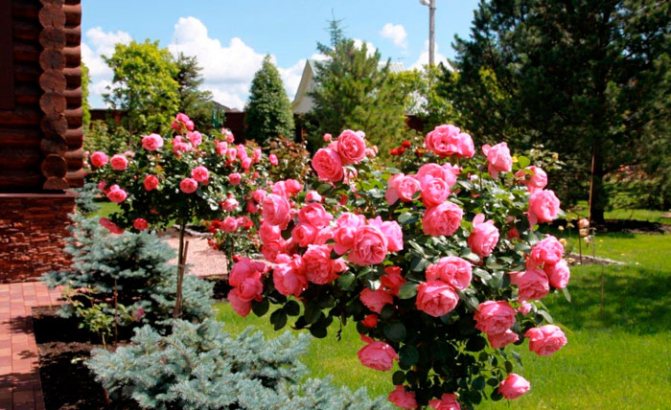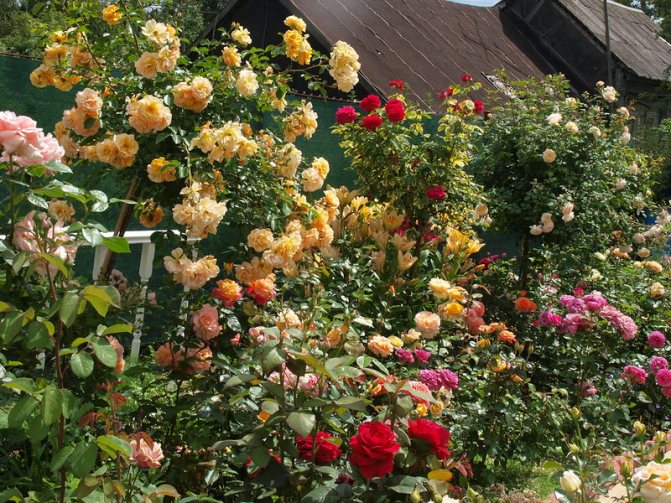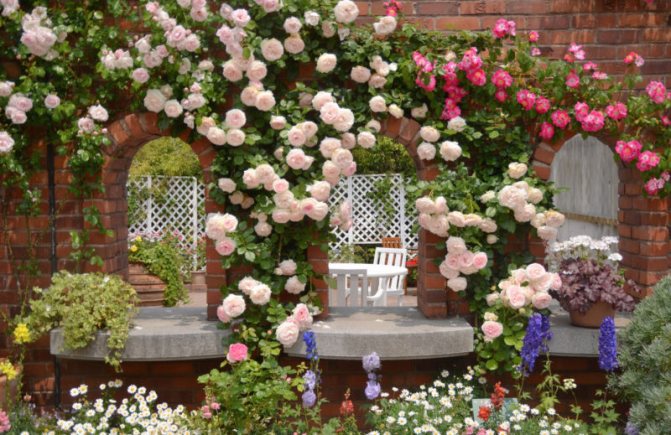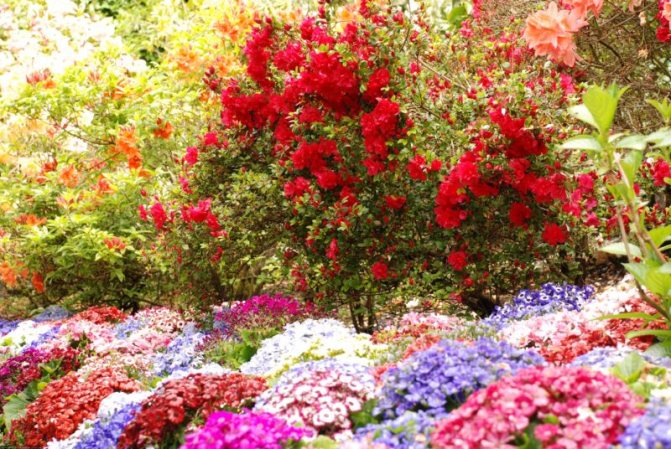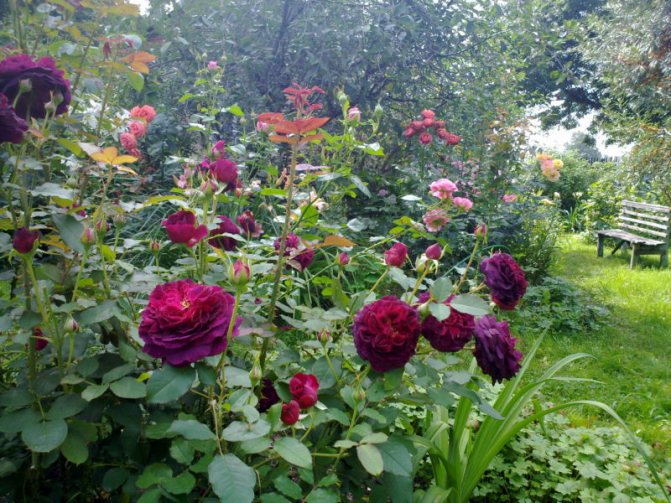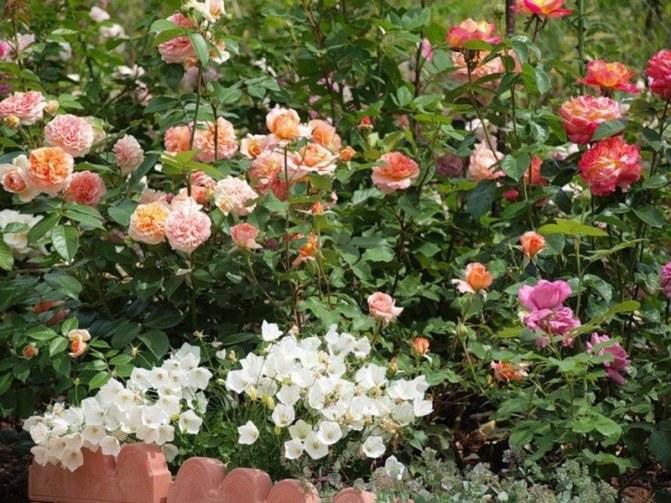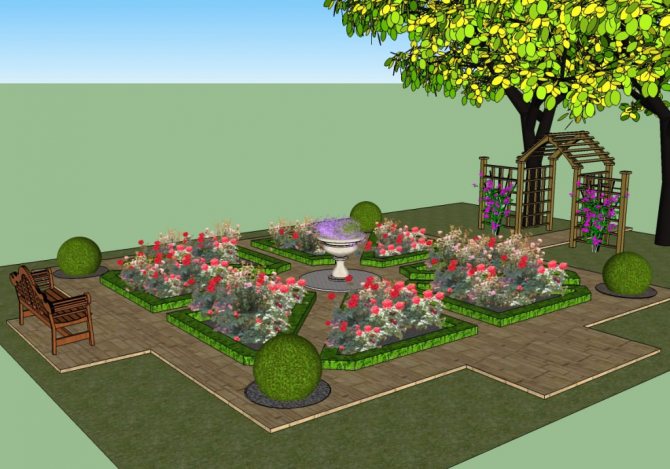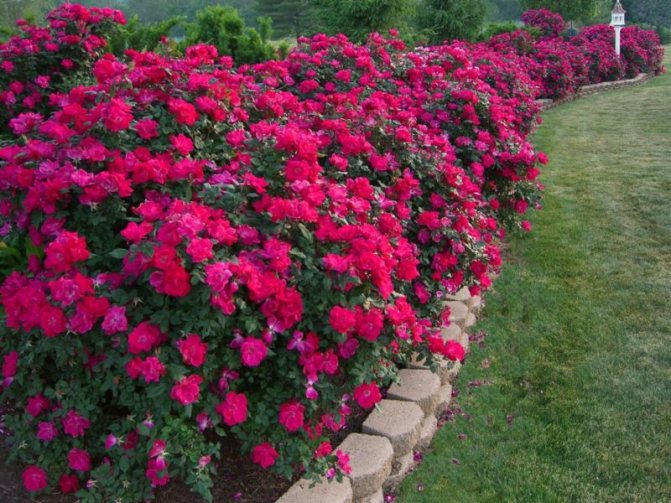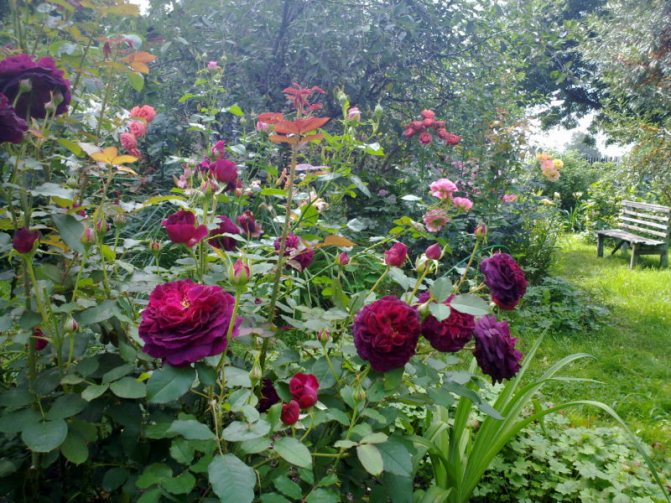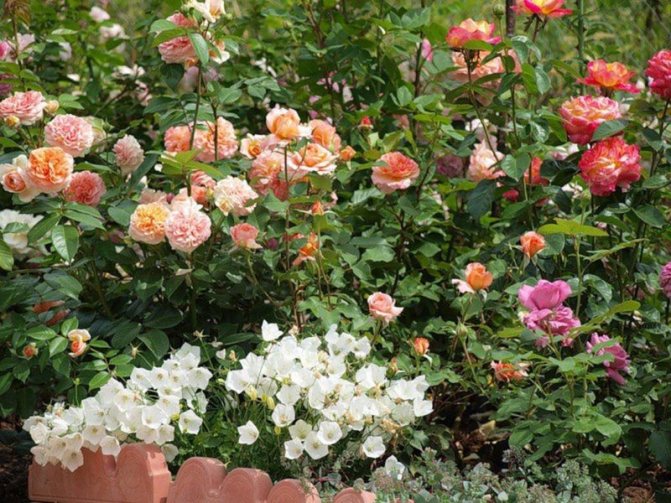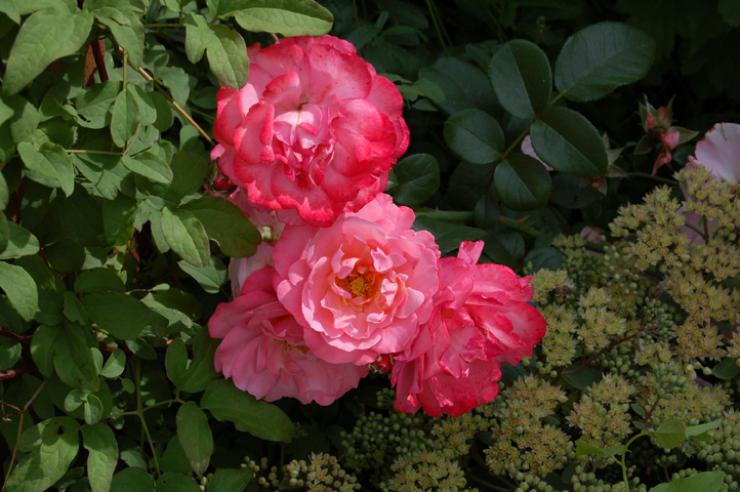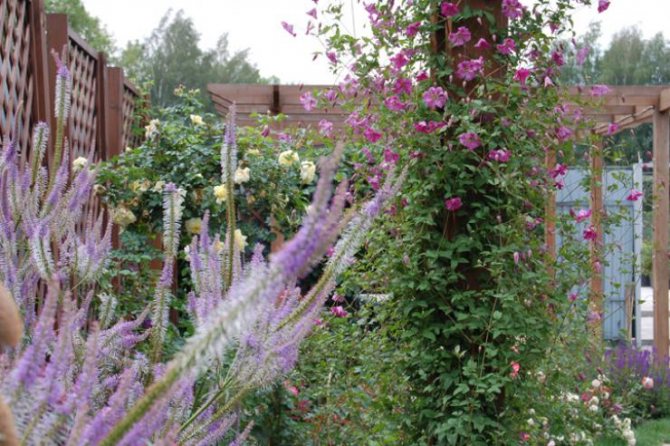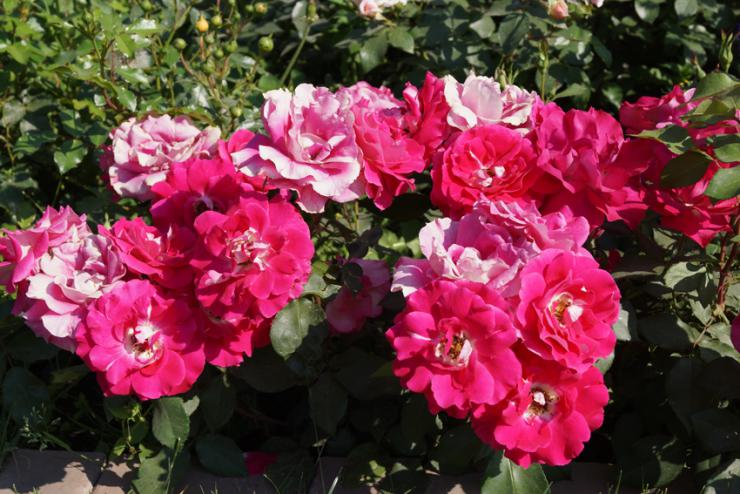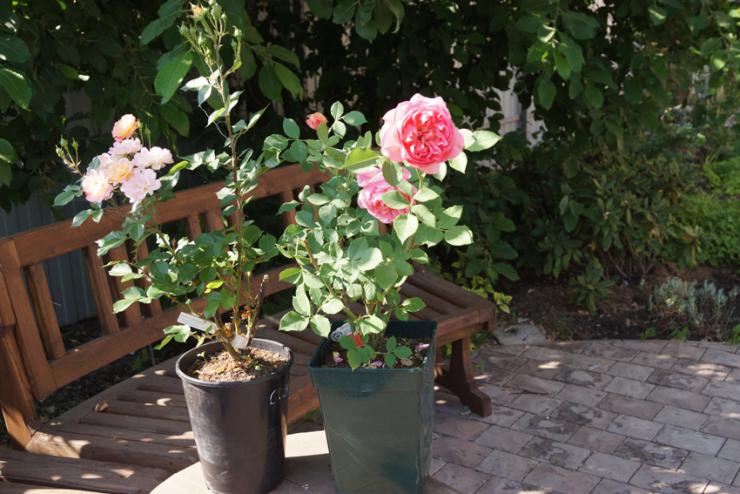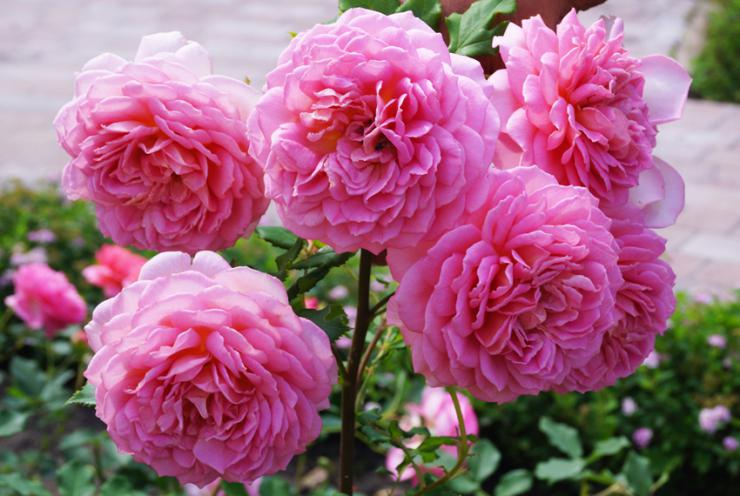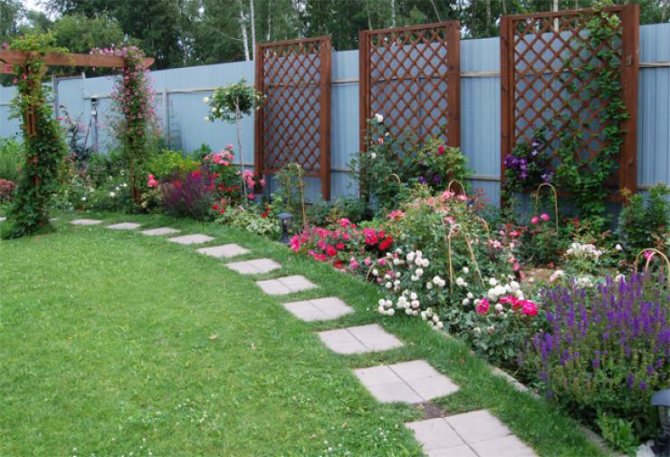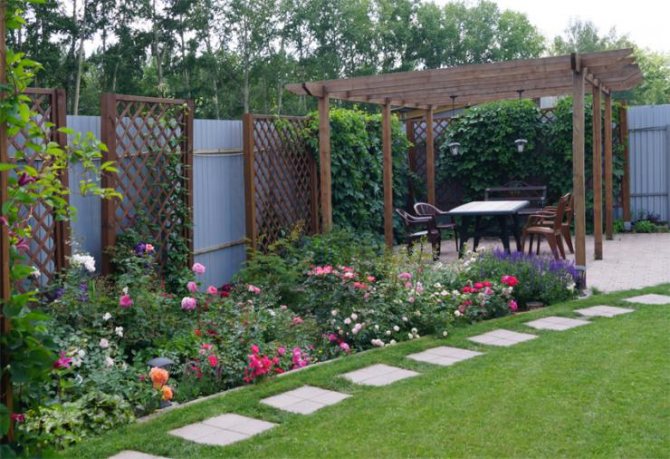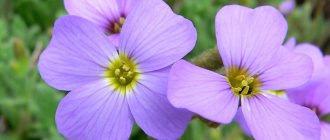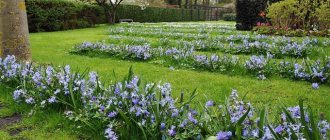Added: Oksana June 1
A noble rose is able to revive a green lawn and a blank wall of a fence, paint a garden landscape in bright colors, and fill a site with a fragrance. A rose garden in the garden, or maybe not one, today is no longer a pipe dream, but a reality available for anyone who wants to realize it.
- 2 Choosing the layout of the rose garden
- 3 Thinking over compositions of roses
- 4 Decorating a rose garden
- 5 Advantageous neighborhood: roses and other plants
Styling options
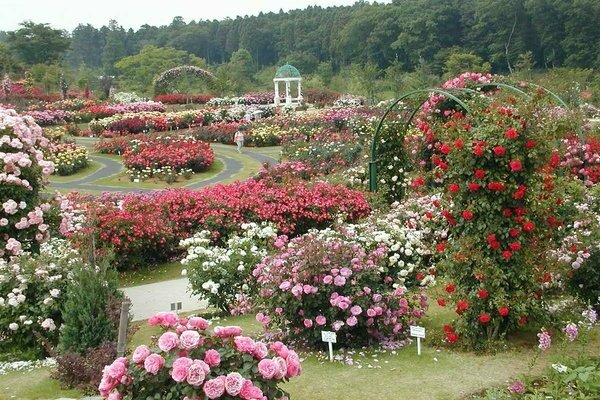
A gardener who decides to build this type of flower garden on his site needs to choose from two style directions of landscape design - landscape or regular.
Having chosen a regular style, you need to decide on the shape of the future flower garden - it should be geometrically correct and neatly decorated. A framing of small pebbles or crumbs will add clarity to the contours. As an addition to the overall composition of the rose garden, hedges, green lawns, paths are suitable.
The landscape direction assumes great freedom and leaves room for the gardener's imagination. There are no strict forms and rules for the placement of plants; often plantings are placed in groups consisting of a large number of plants.
Views and styles
A great decoration is roses in the garden. Making a rose garden does not require too much effort. Before creating a perennial rose flower garden near the house, you need to think about what you want to see in this corner, how it will look schematically. There are several types of design:
the rose garden will look good near the gazebo. It is distinguished by delicate shades. Such a flower garden, in combination with tall plants, creates an atmosphere of peace and comfort;

romantic- ceremonial - is a festive composition with bright, catchy colors, often contrasting. Greenery looks advantageous and elegant here;
- visible from one side... A good option for decorating a small area. This rose garden can be used to decorate a fence or wall. To create it, park tall roses are placed in the background, groundcover in the foreground, and looped, medium-sized flowers closer to the edges;
- visible from different sides... For this rose garden, flowers should be planted from the center outward. The tallest plants are placed inside. They are surrounded by medium-sized flowers. Low-growing varieties complete the composition;
- vertical... Perennial climbing roses will perfectly decorate a gazebo or an arch, covering the entire structure over time;
- rose garden - rock garden... For it, ground cover varieties are used that are unpretentious in care and bloom profusely. Due to the fact that roses of this type grow well, they soon turn into a motley fragrant carpet.
- mobile rose garden - a mobile flower garden, which is arranged in flowerpots and containers. It looks very good at the entrance, along the paths in sunny places. Abundant flowering, low varieties are most suitable for him. For the winter, the containers are removed to a warm room.
Next, you should decide on the style of the rose garden. The most common in modern design are:
- regular style, which is a flower bed of the correct geometric shape (round, oval, rectangular). It is bordered with pebbles, small stones and chips of brick or marble. This style is suitable for large areas.Garden decorations and a lawn will be a beautiful addition.
- landscape... This style does not require a strict disembarkation order. Its characteristic feature is the combination of plants of various sizes, shapes and colors. Such a flower garden can decorate a pond or a small area.
Choosing a place for the rose garden
When choosing a place to place a rose garden, it is necessary to take into account a number of important points:
1) Firstly, preference should be given to sunny and wind-protected areas of the garden. Partial shade is also suitable for growing roses, but in a shady corner, they will not be able to develop in full force. Ideally, the rose garden is in partial shade during the hottest time of the day, and in the sun during the rest of the day. Thus, the most suitable for a rose garden is the south side of the garden plot.
2) The degree of soil moisture is one of the most important factors affecting the success of the entire enterprise. Roses do not tolerate stagnant moisture, so the areas chosen for the rose garden may require drainage with sand.
3) The composition of the soil also plays an important role. Roses prefer slightly acidic loam; in case of excess clay in the soil, it can be corrected by adding peat or sand.
4) Traditionally, rose gardens are located in the immediate vicinity of a gazebo or other vertical structure. This will allow the climbing roses to cling to the support and lift up.
5) When planting roses in a flower bed, you should take care of its decorative design, for which evergreen shrubs that form a low border are suitable.
6) It is better to plant abundantly flowering varieties of roses near water bodies and next to lawns. Dense pink thickets can form a hedge.
Having decided on the location of the rose garden, you can proceed to the choice of plants to fill it. Different varieties of roses should be planted, taking into account the height of their stems: first, low-growing varieties are planted, then medium-tall roses and, finally, tall varieties are placed next to the supports.
Rosary - "royal" highlight of the garden
Roses have one wonderful quality: they impart nobility and graceful severity to everything they touch. An ordinary glass looks like a vase if you dip a stem with a delicate bud into it. A rose bush by the steps makes the porch look like an ancient Roman portico, and a small flower bed with roses will give your modest country garden the look of an exquisite garden.
When planning the design of a beautiful garden, it is simply impossible to refuse the arrangement of a luxurious rose garden. On the contrary, it is often the rose garden that is introduced into the sketch drawing in the first place, assigning the best place, brightly lit by the sun, for it. Of course, it is better to entrust the creation of a rose garden according to all the rules of landscape design to a professional. For those who like to do everything themselves, we can give some valuable advice.
Solved: create a rose garden in the garden
Preparation
Do not spare the most fertile piece of land for the future garden decoration. It is desirable that it be visible from everywhere and especially from home. One glance from the window or from the porch at the blooming miracle will remove the morning lethargy and lift your spirits.
Decide on the rose neighbors. The queen of the garden cannot stand the bright, large flowers nearby during the flowering period. But perennials and cereals will only emphasize its beauty. In addition, it is with the help of tall, tough cereals that you can give the rose garden harmony and completeness. From perennials, choose hosta, tenacious, heuchera, gypsophila. From cereals - Chinese miscanthus, reed grass, blue lightning.
An excellent aesthetic effect will be given by the arrangement of a pink flower bed next to the conifers: thuja or juniper - both partners will benefit.
The rosary will require noble edging: tile, stone, or a low light fence. The path to the rose garden will also have to be paved: do not deprive guests of the pleasure of admiring the fruits of your labors.
Soil for roses
Think carefully about the varieties for the future rose garden: tireless breeders have bred more than 30,000 varieties - one more beautiful than the other! However, many of them are mutually exclusive due to the special requirements for the soil. Before buying planting material, study its compatibility, so as not to ruin the capricious beauties!
Check the groundwater depth under the rose garden. If the depth is less than 1.5 m, drainage is required.
Having marked out a plot for a flower garden, they dig up the top layer of earth by 60-70 cm. The bottom of the niche is covered with expanded clay, gravel or small pebbles and filled with dug earth, almost half mixed with compost. It is useful to add a little peat, sand and black soil.
Rose seedlings are planted in holes 50-60 cm deep and lightly tamp the ground around.
- If roses have wintered in the refrigerator or basement, then at the end of April they can be planted in a flower garden.
- If the seedlings were grown in a greenhouse, plant them when the heat is established - at the end of May - June. Seedlings planted earlier will have to be carefully covered from the cold at night.


Varieties of roses
- Low-growing varieties Decorative and border roses reach a height of 30-35 cm, and some varieties belong to ground cover plants and can creep along the ground and take the form of bushes. A carpet of roses not only looks impressive, but is also quite unpretentious - it does not need to be cut and weeded often, creeping roses will displace weeds on their own. For the winter, for undersized varieties of roses, shelter will be required. - Medium-high varieties This group includes roses that reach a height of 75-90 cm. As a rule, they are distinguished by abundant and long flowering, unpretentious nature and disease resistance. Representatives of medium-high roses include hybrid tea varieties, David Austin roses, floribunda group of varieties, shrub roses. - Tall varieties Varieties of this group can grow up to 130 cm, and climbing roses - up to 4-6 m. For such plants, you should prepare in advance a support for which they will cling, going up. Not all climbing varieties boast lush, beautiful flowers, so you should pay attention to the large-flowered varieties that bloom twice a year.
We decorate the rose garden
In the rose gardens, according to the established tradition, various decorative elements, small architectural forms are actively used: flowerpots, fountains, pergolas, sculpture. Climbing roses are planted near the pergola and trellis-retaining trellises.
In addition, roses can be planted in containers, which are placed on terraces, open areas, a gazebo, along the paths. It is not recommended to grow tall varieties of roses and shrub roses in containers, as they require a large area of nutrition.
PATIO roses are best suited for flowerpots.
However, you should take care not only about the size of the flowerpot and rose bush, but also about the proper care of the roses. First of all, the flowerpot should have a good drainage layer and fertile soil, roses like regular watering and feeding. Such flowerpots should be located in well-lit places. For the winter, flowerpots are moved to the winter garden or to the basement.
Rosary: layout
The plan for the future rose garden should be developed in advance, this will allow you to work out in detail all the nuances of the design and its design. For example, choose a color scheme and a corresponding flower garden design. So, roses of delicate pastel shades will create a romantic look of the rose garden, and large red or yellow flowers will add brightness to the design. Experienced gardeners can afford to experiment with contrasting combinations to find a personalized garden solution.
In addition to the color palette, there are a number of other interesting ways to design a rose garden: - in addition to roses, you can use other plants that can serve as an accent, more fully revealing the compositional intention; - the use of evergreen shrubs,conifers, ferns will create a winning background; - it is necessary to take into account how different types of plants interact with each other in order to avoid their enmity and diseases; - at the stage of developing a plan for a future rose garden, it is recommended to determine the position of each element, this will help create a balanced composition.
How to start creating a rosary
You need to start any business with an adequate assessment of your capabilities, before you create a rose garden, you also need to think carefully. So what do we have in stock? We will need:
Plot of land
- If you have a large personal plot, and you are ready to give it all entirely for a rose garden, then you can make a large and even a huge garden with roses.
- If you have a little land or one greenhouse, we are planning a small rose garden.
- If you only have a balcony or a loggia - well, that's not bad - even 2 square spaces are enough to create a mini rose garden.
- And if you don’t have this either… don’t despair! We will adapt a window sill or a corner in the room for a rose garden.
Large instrument
For planting roses outdoors and in greenhouses, you need a good shovel. Moreover, this tool must be chosen carefully. If you knew how many flower beds were started and abandoned by novice gardeners just because they came across a bad shovel, then now you would not grin so much while reading these lines. In fact, we will need as many as three shovels, and each of them is irreplaceable! Read about which shovels you need for planting a rose garden and how to choose them here. In addition, you must prepare a couple of special rakes (more on that here). You also need 2 buckets and 2 watering cans (more on that here).
Small tool
- A set of shovels for planting and mini rakes;
- measuring beaker with clear marks;
- a pair of plastic bottles for 2 and 5 liters;
- good secateurs (small and large);
- very sharp knife;
- tape measure, pegs, a roll of rope and a can of paint - they will come in handy for marking the rose garden.
Composters
If you want to do everything right at once - and this is the only way to work with roses, then prepare as many as 2 compost boxes. One will serve to process everything from which an excellent fertilizer can be obtained. In the second, you will put in plastic bags everything that is subject to export and destruction - cut leaves from seedlings, which can be infected, sick and pest-affected plants.
Attention! Only after collecting everything you need, proceed to the next stage! Get used to working with roses so that everything is perfect!
Rosary: preparing the soil
It is better to prepare the soil in the area set aside for the rose garden in advance - from autumn or even from the end of July. First of all, it is necessary to dig up the soil to a depth of 0.5 m. Then, based on the composition of the soil, it is recommended to make appropriate fertilizing, if necessary, carry out drainage work. Of organic mixtures, fertilization with humus, compost, rotted manure, peat is best suited. Mineral mixtures preferred for roses include ammonium nitrate, potassium chloride, superphosphate.
Implementation of the project
The most favorable period for planting roses is autumn., But you need to start creating a rose garden from the summer. You can see this creation process in detail in the video at the end of the article.
Before planting roses, you must carry out the following work:
- Clear the area. This applies not only to garbage, but also to weeds. Also, when creating a traditional rose garden, it will not be superfluous to level the territory.
- Dig up the soil to a depth of about 60 cm. Thus, the soil is loosened and, therefore, aerated.
- If the soil is poor in minerals and organic elements, fertilizer should be applied. The norm is about 10 kg of organic and 100-150 g of mineral fertilizers per 1 m2.
- Make drainage. Especially important on heavy clay soil.Drainage is expanded clay, coarse sand or gravel, added directly to the hole before planting or backfilled throughout the territory under a fertile soil layer.
After 1-2 months after preparing the soil, you can start planting flowers. Particular attention should be paid to seedlings:
- A lump of earth at the root should not crumble. If this is a seedling from a container, then before removing it, you need to moisten the soil well. A plastic pot can be simply cut open.
- If seedlings are used, then you need to process the roots - cut them to a length of 30 cm, and also remove dry and spoiled areas. After that, the roots should be dipped in a solution of activated carbon or a mixture of clay and manure.
- The ground part of the plant should also be shortened, leaving no more than 3 stems without leaves.
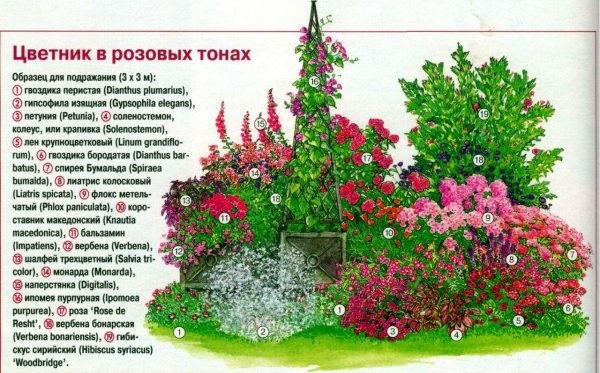

Preparing for winter
Not all roses need to be covered. Old and specific varieties may well overwinter on their own. By autumn, their bark coarsens, and plants are able to meet cold weather. Modern remontant varieties need shelter.
Tips from experienced florists:
- In August, the bushes are fertilized with phosphorus compounds.
- The tops of the shoots are pinched.
- Beginning in September, all excavation work in the rose garden should be stopped. This will reduce the chances of your kidneys waking up.
- In October, the shoots of roses are cut to a third of the length.
Before the very frosts, the plants are covered. In terms of time, this is approximately the end of October, November. Spruce branches, leaves, sawdust, snow are most suitable. First, you can cover the roses with spunbond, and then fill up with what is selected as the material. After the first heavy snowfall has passed, the plants are covered with snow.
Making a rose garden at a summer cottage is not so difficult. And it will bring a lot of pleasure. The main thing is to decide on the plan of the flower garden, to think over which plants will enter the flower beds. The rose is whimsical to care for, but the effort spent will be rewarded with lush flowering and enthusiastic glances from everyone who manages to meet this beauty.
Selection of compositions by color
One of the main nuances that guarantee a magnificent landscape landscape is the color combination of roses. According to existing rules, monochromatic plants are planted in 3-5 bushes, and two-colored roses are placed separately. To create a beautiful flower garden, it is important to observe the height of the plantings and the same flowering period.
The creation of monorosariums is the most difficult process, which requires the correct combination of roses of different heights. You can add other plants to the composition by combining them in associative opposite shades.
To create a landscape that is attractive for a long time, you can plant decorative cereals at the foot of the roses, decorating the background with conifers. Thus, the flower garden will attract attention not only during flowering, but also after.
Monochrome color scheme involves the selection of roses of the same color, inside which various shades are combined. The result is a soft stylish transition. You can choose several colors: white, yellow, pink, red, etc. They need to be spotted according to the intensity of the color in different corners of the garden.
The monochrome group created by different varieties of roses inside the color looks interesting. You can support the rose garden with other perennial plants: hydrangea, delphinium, lavender, etc.
Another color scheme: two contrasting colors are combined into one group. It should be borne in mind that white will contrast with any other. He attracts attention to himself.
Examples of contrasting combinations:
- yellow with purple (lilac or lilac);
- green with red;
- blue with orange.
The contrasting design of the rose garden is bright and juicy. Such a flower garden always attracts attention.
By choosing colors that are close in color (warm to warm, cold to cold) in one group of a rose garden, color combinations are pleasant to the eye. For example:
- orange and yellow with red;
- lilac and pink with lilac;
- green with white.
White with green gives a natural, sophisticated and sophisticated combination.
How roses hurt and methods of treatment
Breeders develop disease-resistant varieties, but still, a rose lover should be prepared to protect their pets from many potential threats. The good news is that almost all of them can be overcome.
Black spot
The first major attack is the fungal disease "black spot", which is promoted by high summer humidity.
Signs of the disease leading to the death of the plant: the appearance of black spots on the leaves, which then fall off.
Treatment: spraying with preparations based on fungicide and triazole.
Powdery mildew
Powdery mildew appears on roses when the temperature regime changes dramatically: hot during the day, cool at night. White moldy bloom appears on the leaves, and the leaves curl. In order to avoid illness, it is necessary to place the rose garden in a ventilated place and treat it with ash.
Treatment: urgent spraying with Bordeaux liquid or copper oxychloride solution.
"Rust"
Rust also appears due to high humidity. It is easy to identify it; characteristic growths of a rusty color appear on the branches.
Treatment: first of all, it is necessary to cut off all infected areas and destroy. Treat with antifungal fungicide.
How to choose varieties


Arranging a rose garden with their own hands at the dacha, they select the types of plants. This takes into account:
- Where roses will grow.
- Will regular care for them be possible.
- How many bushes to place in the flower garden.
When these questions are answered, it will be easier to pick up the varieties of roses. For arches, trellises or porches, climbing specimens are suitable. They can create a background for other plants or serve as a screen in a specific area of the garden.
If the owner rarely visits the country, unpretentious varieties that are resistant to diseases and pests and do not need winter shelter will suit him. These will be park and landscape views, characterized by long flowering and a wealth of colors.
Rose lovers who can provide the plants with proper care can plant sharabas or tea varieties. In a large area, you should not plant only species with long flowering. You can plant varieties that bloom once, and supplement them with specimens with a long flowering period.
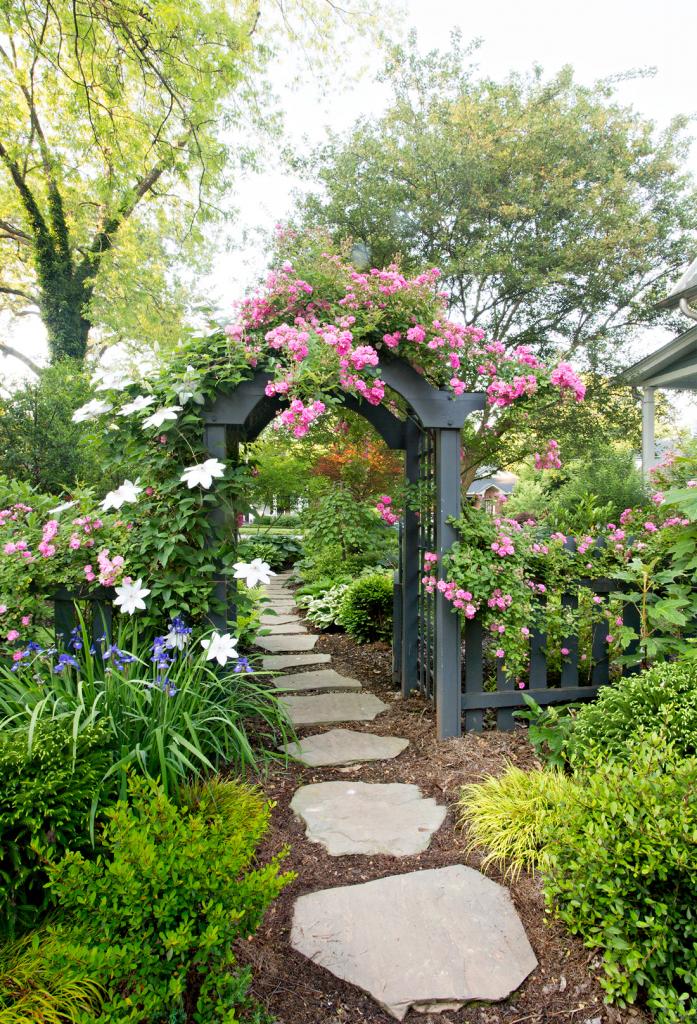

Care rules
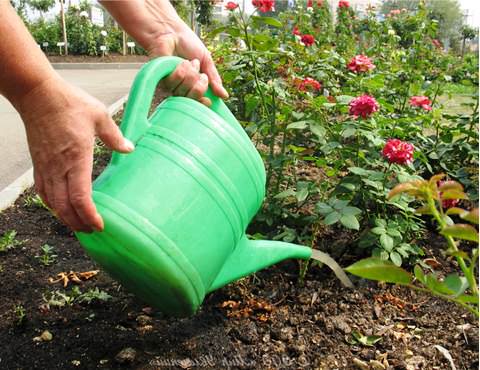

The first 2 weeks after planting, it is necessary to regularly water the bushes so that they take root in a new place. In the future, watering the plants should be carried out no more than once a week. It is necessary to ensure that there is a sufficient amount of water, it is directed at the root and does not fall on the foliage. The watering rate is 1 bucket of water per bush, but in hot dry summers it can be doubled.
When there is no opportunity to regularly water the plant, the soil around the roses should be covered with a layer of cut grass, tree bark or humus. This will help retain moisture and prevent weed growth. With a lack of moisture, the flowers become small, and with an excess of moisture, the supply of oxygen to the roots is reduced, as a result of which the leaves turn yellow.
Insufficient watering of roses causes the formation of superficial roots that are easily damaged.
Roses must be pruned in spring, summer and after flowering. Removing the inward-growing shoots stimulates the emergence of new stems. Cutting withering buds saves the strength of the plant and accelerates the formation of the next flowering wave.
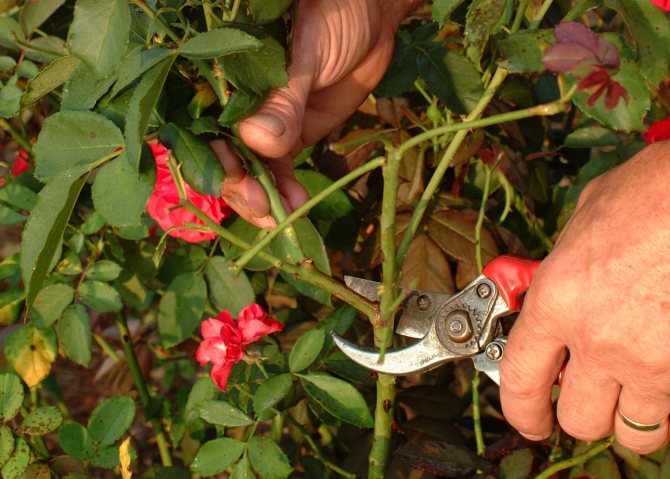

You also need to regularly loosen the soil around the plants and fertilize the bushes during the period of active growth so that your garden is filled with the delicious scent of blooming roses.
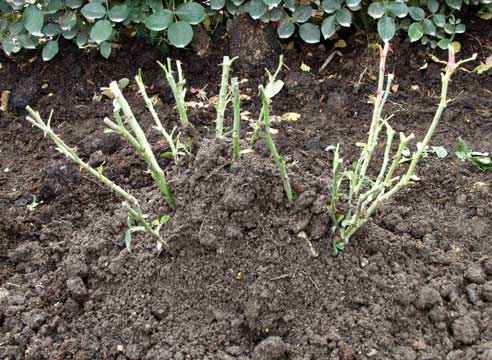

Horse manure is considered the best fertilizer for roses, but pork or chicken manure can seriously harm the plant - there is a high risk of burning young shoots. During the budding period, the bushes need to be watered with a solution of calcium nitrate, prepared in a proportion of 1 tbsp. l. fertilizers per 10 liters of water.
During active flowering, roses are watered every 10-15 days with herbal infusion.The most favorable time for fertilizing is immediately after watering. In the second half of summer, feeding is stopped, the plant prepares for winter.
Combination with other plants
A live fence of boxwood or thyme can be planted around the rose garden. In addition, the plant goes well with barberry, asters, santolina, irises, primroses, carnations, begonias, dolphins, pansies, clematis, hosta, heuchera, ferns and coniferous shrubs.
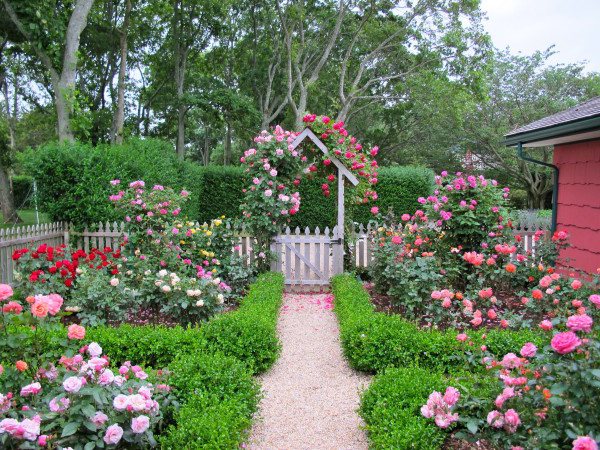

Placing roses near marigolds, sage or lavender will help prevent diseases and pests.
Rose garden in the country: a photo of a beautiful design, a diagram of the device and care
Probably everyone at least once thought that a beautiful flower garden in the garden will always give an unusual atmosphere and fragrance. But do not rush to look for a company that will help you with drawing up a composition of flowers, because if you have a strong desire, you can make a rose garden with your own hands.


The important part will be that it is you who will make the flower garden, place the flowers the way you like.
Perhaps you now think that the design takes a lot of time and effort? In a way, you are right, but trust me, the composition you put together will be worth your effort. For example, you can see a photo of the rose garden. This business will need to be approached with all responsibility, because some unaccounted for details can ruin your rose garden.
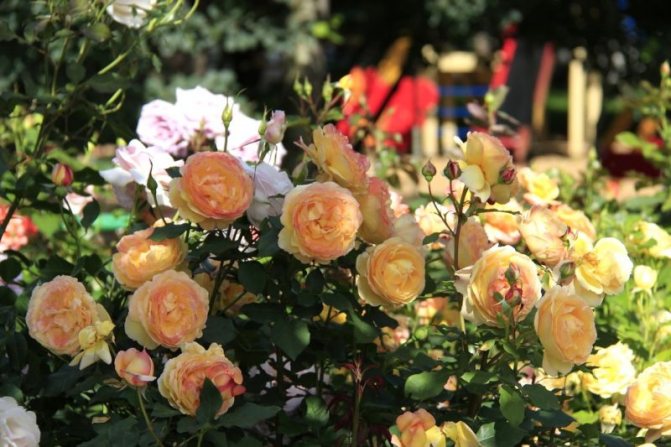

Planting a rose: by seeds or seedlings
Most often, a rose is planted with cuttings, because it quickly takes root and in the same year it pleases with its flowering. Grown grafted seedlings are sold in two versions:
- in containers;
- with open roots.


If you come across a good option in the summer, then get a pot with a seedling. The flower should look "cheerful", have a good root system, abundant shiny foliage
Where to plant a rose: favorable climate and temperature
Roses love everything in moderation: they cannot stand the heat and severe frosts, they cannot without abundant watering, but waterlogging harms them. The ideal condition for the good development of roses is considered to be a temperature of up to 25 degrees in summer. They should be planted in a sunny area, preferably protected from the winds.
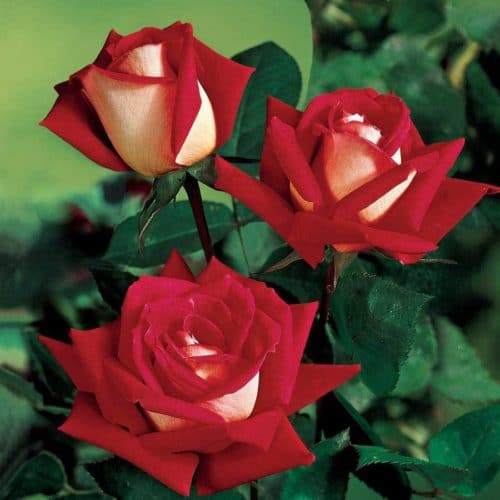

You can choose varieties that are resistant to maximum temperatures, winter-hardy and withstand the scorching rays of the sun
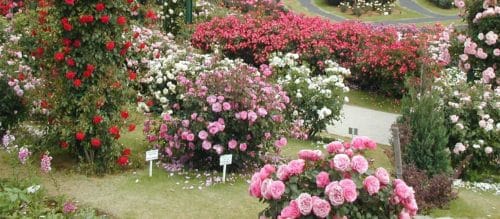

Roses can grow alone and combine into flower beds of roses, serve as a hedge and decorate the facade of the house
Planting flowers
You will be preparing the site for laying out the rose garden for at least 2 months. Since planting should take place in the fall, then from the middle of summer you will have to start preparing. In July, you need to dig up the selected area, the depth should be about 50 cm. Apply all the fertilizers and loosen the top layer.
Before planting, you need to carry out the following procedures:
- Moisten the roots of the seedling and cut off any broken or damaged branches;
- The part that remains above the ground must be shortened and left up to 3 shoots, on which there should be no leaves or other shoots;
- The seedling should be positioned exactly vertically, do not allow the roots to twist up.
When planting is complete, compact the soil well, pour it with settled water, loosen the top layer and cover with a layer of peat that will cover all the shoots above the soil surface. After wintering, the roses need to be pruned a little and lightly covered with bark. When the seedlings grow 5 cm, it is necessary to re-lay the peat layer.
Where to buy seedlings
High-quality planting material is the key to a successful rosary. If you have received your own material from the seeds, honor and praise you. But not many decide to do this and buy seedlings. It is best to buy the material from specialized stores and nurseries. This ensures that the variety you have chosen will meet expectations and will be healthy.
It is not recommended to purchase from casual sellers, as:
- it can become a source of infection for the entire garden;
- to be "wild".
In stores in the midst of winter, you can come across a "sale" of seedlings of roses from foreign nurseries, not sold out in the fall. They can be purchased, but there is no guarantee that they will last until spring.
Color combination options
- In classical type rosaries, plants with red, white and pink flowers are most often used. Compositions can be either monochrome or combined. Experienced flower growers create strikingly beautiful rose gardens, the flowers in which reproduce a certain pattern: all kinds of ornaments, geometric shapes, intertwining rings and flounces.
- Flower gardens are very popular in which plants are planted in order to create a smooth color gradient.
- Compositions that use flowers with petals of lilac, violet and lilac shades are especially beautiful, allowing you to create a very gentle transition from pale pink to lilac-burgundy tones.
- Most often, flower arrangements are created on the basis of sharp color contrast.
- If the owner of the site likes soft and warm colors, he may well plant flowers of exclusively this color.
- The shades of yellow, scarlet and orange have always been very popular. Thanks to the work of breeders, a huge number of varieties with orange, peach and apricot petals have recently appeared. In no case should you place them together with white roses and any variations of cold tones. There should be no wine-pink, cherry, purple and burgundy shades next to such flowers.
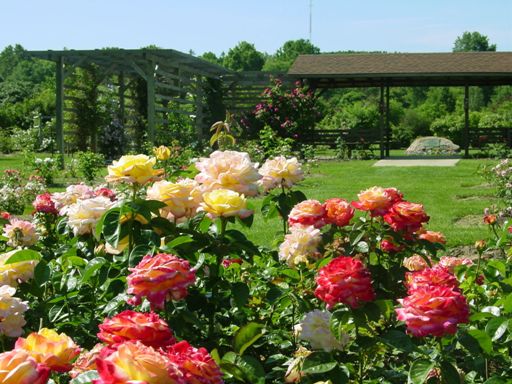

The rose garden will always bring a bright accent to the atmosphere of your site
Rose garden in the garden. What to plant with roses in a flower bed.


Roses: Jubilee Celebration, Princess Alexandra Of Kent, A Shropshire Lad, Christopher Marlowe, William Shakespeare 2000. Partners: Delphinium hybrid, lavender, gray fescue.


Roses: Golden Celebration, Summer Song, Grace, Lady Emma Hamilton. Partners: geychera, chisel, foxgloves, barley, annual hare tail, fescue, bulbous ryegrass.
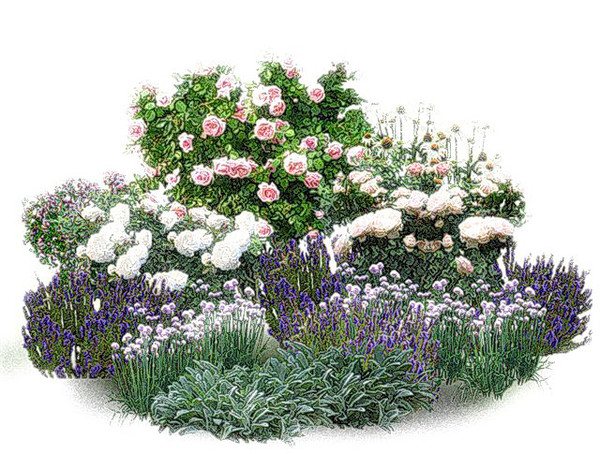

Roses: Abraham Darby, Sharifa Asma, Winchester Cathedral. Partners: oregano, evening primrose, bows, hyssop, monarda, purse.


Roses: A Shropshire Lad, Pat Austin, Molineux, Grace, Jude the Obscure. Partners: cereals, Siberian irises, sage, geychera, purse, lavender.


Roses: William Sheakespeare, Molineux. Partners: thuja, cereals, heuchera, lavender.
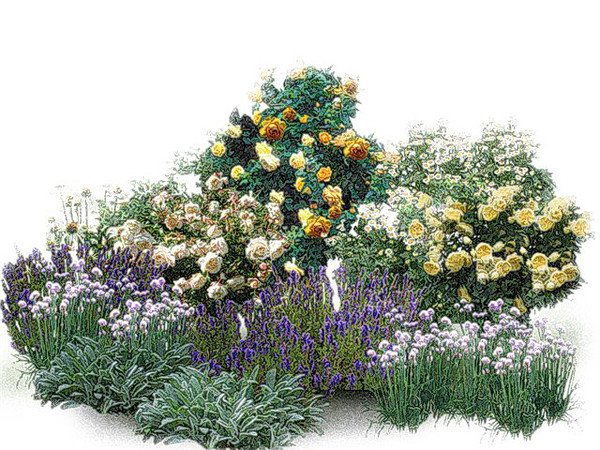

Roses: Crocus Rose, Golden Celebration, the Piligrim. Partners: oregano, onions, evening primrose, hyssop, purse, maiden feverfew.
Complementary feeding and pest control
Regardless of the variety, the rose needs harmonious nutrition: it is impossible not to feed it, but overfeeding also harms it. After planting, you should be careful with complementary foods - 2 times a summer in small doses is enough. In the second year, you can get down to business thoroughly. Basic fertilizers and the effect they produce:
- Nitrogen provides accelerated growth and promotes flowering, therefore, it is applied to the soil in May.
- Phosphorus strengthens the shoots and allows the roses to bloom more often and the buds to be larger. The feeding period lasts from June to September.
- Calcium leaches the soil, creating conditions for the development of beneficial bacteria.
- Potassium influences bud formation, subsequent flowering and helps to withstand cold winters. It is introduced into the soil from early summer to mid-autumn.
- Trace elements increase the protective properties of the plant, therefore, the plant needs the entire growing season.
Roses with good immunity will withstand the invasion of pests, but they must be helped. Insecticide treatments in the midst of control and prophylactic purposes are effective. You need to know the pests of garden plants dangerous for roses by sight!


Rose aphid instantly clings to the plant and draws juices from it. You can fight it effectively in the first three days. It is necessary to wash off insects and process bushes
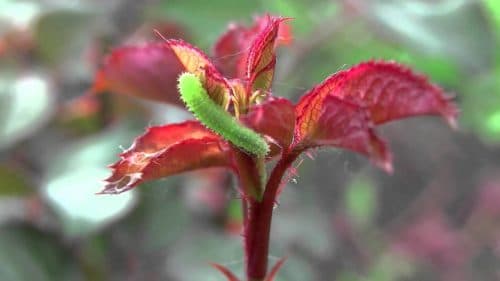

It is hard not to notice the rose-colored sawfly - a green caterpillar eating leaves to a skeletal state
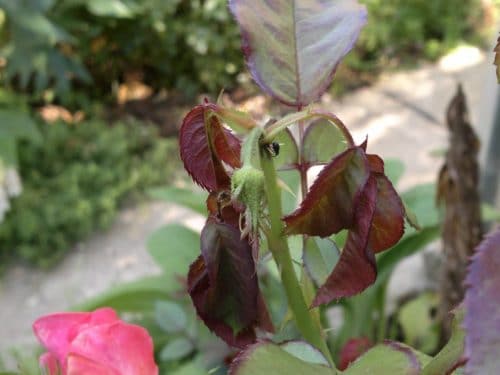

Weevil is a small bug that can do great harm by gnawing the flesh of leaves, buds and roots
In the fall, for prevention, dig up the soil and treat it with a solution of ordinary potassium permanganate. Pay attention to your beauties, attract beneficial insects to the site and avoid threats.
Layout plan and charting
The first thing you need to pay attention to when breaking down a rose garden is the color range of flowering. Be sure to take care of plants that will break the variegation, these can be perennials or evergreen shrubs. Ferns and conifers create a favorable background and give the rose garden more picturesque (read also the article "Sauna in the country and its design features").


An indicative diagram of a rosary in the country
Arm yourself with a piece of paper and sketch your idea of a rose garden, this will be your sketch - the first step to creating a corner of paradise in the country.
A harmonious combination is obtained from varieties of cream and white roses, the beauty of which will be complemented by perennials with lilac inflorescences


